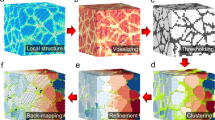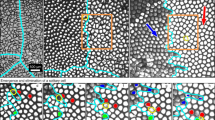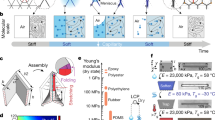Abstract
Cellular structures or tessellations are ubiquitous in nature. Metals and ceramics commonly consist of space-filling arrays of single-crystal grains separated by a network of grain boundaries, and foams (froths) are networks of gas-filled bubbles separated by liquid walls. Cellular structures also occur in biological tissue, and in magnetic, ferroelectric and complex fluid contexts. In many situations, the cell/grain/bubble walls move under the influence of their surface tension (capillarity), with a velocity proportional to their mean curvature. As a result, the cells evolve and the structure coarsens. Over 50 years ago, von Neumann derived an exact formula for the growth rate of a cell in a two-dimensional cellular structure (using the relation between wall velocity and mean curvature, the fact that three domain walls meet at 120° and basic topology). This forms the basis of modern grain growth theory. Here we present an exact and much-sought extension of this result into three (and higher) dimensions. The present results may lead to the development of predictive models for capillarity-driven microstructure evolution in a wide range of industrial and commercial processing scenarios—such as the heat treatment of metals, or even controlling the ‘head’ on a pint of beer.
This is a preview of subscription content, access via your institution
Access options
Subscribe to this journal
Receive 51 print issues and online access
$199.00 per year
only $3.90 per issue
Buy this article
- Purchase on Springer Link
- Instant access to full article PDF
Prices may be subject to local taxes which are calculated during checkout


Similar content being viewed by others
References
von Neumann, J. in Metal Interfaces (ed. Herring, C.) 108–110 (American Society for Metals, Cleveland, 1952)
Mullins, W. W. in Metal Surfaces: Structure, Energetics, and Kinetics (eds Robertson, W. D. & Gjostein, N. A.) 17–66 (American Society for Metals, Metals Park, Ohio, 1963)
Mullins, W. W. Two-dimensional motion of idealized grain boundaries. J. Appl. Phys. 27, 900–904 (1956)
Glazier, J. A. Grain growth in three dimensions depends on grain topology. Phys. Rev. Lett. 70, 2170–2173 (1993)
Burke, J. E. & Turnbull, D. Recrystallization and grain growth. Prog. Metal Phys. 3, 220–292 (1952)
Durian, D. J., Weitz, D. A. & Pine, D. J. Scaling behavior in shaving cream. Phys. Rev. A 44, R7902–R7905 (1991)
Smith, C. S. in Metal Interfaces (ed. Herring, C.) 65–113 (American Society for Metals, Cleveland, 1952)
Rhines, F. N. & Craig, K. R. Mechanism of steady-state grain growth in aluminum. Metall. Trans. 5, 413–425 (1974)
Rivier, N. On the structure of random tissues or froths, and their evolution. Phil. Mag. B 47, L45–L49 (1983)
Hilgenfeldt, S., Kraynik, A. M., Koehler, S. A. & Stone, H. A. An accurate von Neumann’s law for three-dimensional foams. Phys. Rev. Lett. 86, 2685–2688 (2001)
Hilgenfeldt, S., Kraynik, A. M., Reinelt, D. A. & Sullivan, J. M. The structure of foam cells: Isotropic plateau polyhedra. Europhys. Lett. 67, 484–490 (2004)
Glicksman, M. E. Capillarity-mediated grain growth in 3-D. Mater. Sci. Forum 467–470, 1025–1031 (2004)
Glicksman, M. E. Analysis of 3-D network structures. Phil. Mag. 85, 3–31 (2005)
Hadwiger, H. Vorlesungen über Inhalt, Oberfläche und Isoperimetrie (Springer, Berlin, 1957)
Klain, D. A. & Rota, G.-C. Introduction to Geometric Probability (Cambridge Univ. Press, Cambridge, UK, 1997)
Federer, H. Curvature measures. Trans. Am. Math. Soc. 93, 418–491 (1959)
Fu, J. H. G. Curvature measures of subanalytic sets. Am. J. Math. 116, 819–880 (1994)
Bröcker, L. & Kuppe, M. Integral geometry of tame sets. Geom. Dedicata 82, 285–323 (2000)
Atkinson, H. V. Theories of normal growth in pure, single phase systems. Acta Metall. 36, 469–491 (1988)
Mullins, W. W. Estimation of the geometrical rate constant in idealized three dimensional grain growth. Acta Metall. 37, 2979–2984 (1989)
Hillert, M. On the theory of normal and abnormal grain growth. Acta Metall. 13, 227–238 (1965)
Abbruzzese, G., Heckelmann, I. & Lucke, K. Statistical theory of two-dimensional grain growth. Acta Metall. Mater. 40, 519–532 (1992)
Acknowledgements
D.J.S. was supported by the US Department of Energy and the US National Science Foundation.
Author information
Authors and Affiliations
Corresponding authors
Ethics declarations
Competing interests
Reprints and permissions information is available at www.nature.com/reprints. The authors declare no competing financial interests.
Supplementary information
Supplementary Information
This file contains Supplementary Notes with the derivation of the main result in the Article, Supplementary Equation illustrating the generalization of the von Neumann-Mullins relation to three dimensions and Supplementary Discussion of practical approaches to calculating the mean width of a domain – including exact methods for polyhedra and a few special shapes plus a numerical method for determining the mean width of arbitrary three-dimensional domains. (PDF 167 kb)
Rights and permissions
About this article
Cite this article
MacPherson, R., Srolovitz, D. The von Neumann relation generalized to coarsening of three-dimensional microstructures. Nature 446, 1053–1055 (2007). https://doi.org/10.1038/nature05745
Received:
Accepted:
Issue Date:
DOI: https://doi.org/10.1038/nature05745
This article is cited by
-
Rejuvenation of plasticity via deformation graining in magnesium
Nature Communications (2022)
-
A Three-Dimensional Continuum Simulation Method for Grain Boundary Motion Incorporating Dislocation Structure
Journal of Scientific Computing (2022)
-
Mean Field Modeling of Grain Growth and Zener Pinning
Journal of Phase Equilibria and Diffusion (2022)
-
Linear Relationship Between dV/dt and Grain Volume During Grain Growth
Metallurgical and Materials Transactions A (2021)
-
ReS2 Charge Trapping Synaptic Device for Face Recognition Application
Nanoscale Research Letters (2020)
Comments
By submitting a comment you agree to abide by our Terms and Community Guidelines. If you find something abusive or that does not comply with our terms or guidelines please flag it as inappropriate.



